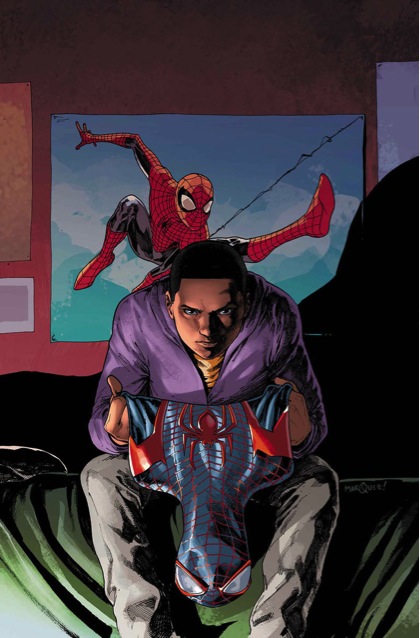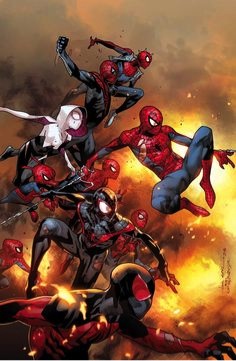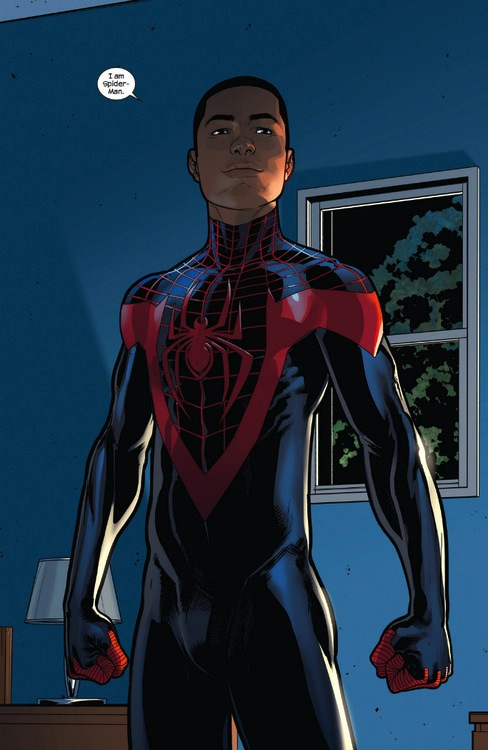In 2011, Spider-Man died. And he was replaced by Spider-Man.
There are a lot of superhero archetypes in comic books. You’ve got your classic patriotic mainstays like Superman and Captain America. Your rich “bad-boy” gadget guys like Iron Man and Batman. Characters seeped in worlds of myth and magic like Wonder Woman and Thor. Supernatural characters like Ghost Rider and Swamp Thing. Cool tough guy loners, like Wolverine, who actually love being surrounded by people. But one of the most famous archetypes of all, the young TEEN hero, was perfected in the sixties by writer Stan Lee and artist Steve Ditko.
Peter Parker has been Spider-Man since August of 1962, and he started when he was fifteen. In all that time, he’s only aged 13 years. That’s how Marvel Comics work, they use a “sliding timeline.” So right now, Peter Parker’s a 28-year-old bachelor making a living in New York City.
I’ve loved Spider-Man since I was five years old, when I came into possession of some Spider-Man comics, I don’t even remember how. Then came the animated Spider-Man series during the nineties, which became my jam. I went above and beyond most regular kids at the time by using the library (this was pre-internet, in the long long ago, in the before time) to learn everything I possibly could about the coolest character I’ve ever seen up to that point in my life. I did research. I checked out books on the history of Marvel Comics. I learned who these guys Stan Lee, Jack Kirby, Steve Ditko and John Romita were. Spidey became my favorite fictional character of all time, and remains so to this day.
I think I realized years later one of the subconscious reasons I was drawn to Spider-Man was because under his costume, he could be anybody, with any skin tone. Even mine. The worlds I’ve been obsessed with since I could read have been mostly populated with mostly straight white men, and that’s mostly fine. I always understand the context of comic books and where they came from. But every year, lucky to be growing up in San Diego, I would see fans wearing the most INCREDIBLE superhero costumes at Comic-Con and without fail someone would get their attention by yelling “Hey! Black Batman! Can I get a picture?” No matter how awesome your Batsuit was, if you were black, you weren’t Batman. You were “Black Batman.” Even Ultimate Spider-Man writer Brian Michael Bendis said that “many kids of color who when they were playing superheroes with their friends, their friends wouldn’t let them be Batman or Superman because they don’t look like those heroes but they could be Spider-Man because anyone could be under that mask.” Yep.
In 2000, right before some big Hollywood movies were about to be released and change the world as we knew it, Marvel launched Ultimate Spider-Man, a new comic set in a new universe retelling the origin (and entirely new stories) of my favorite character. I was obsessed. I read all the new titles in the “Ultimate Universe”, Ultimate X-Men, Ultimate Fantastic Four, and the new modern version of the Avengers, the Ultimates. But Ultimate Spider-Man, written by Bendis and drawn by Mark Bagley, stole the show. For me, this was the definitive young Spider-Man. The stories from the sixties written by Stan and drawn by Steve and John were too dated, I couldn’t relate. But Ultimate Spider-Man showed me what Peter was like as a sixteen year old kid. In our modern world. So I filled in some blanks to get him to 28, over in his “regular Marvel Universe” title, The Amazing Spider-Man, and I was good to go. I had it all.
THE DEATH OF SPIDER-MAN
Then in 2011, something groundbreaking happened to Ultimate Spider-Man. After eleven years, Marvel made a decision. Writer Brian Michael Bendis was inspired by the real world, his daughters, two of whom are adopted and African-American and Ethiopian, growing up in America. He was horrified by the racism he witnessed online after fans petitioned for young, funny, charismatic actor Donald Glover to play the new Spider-Man in Sony’s rebooted film (of which the role eventually went to Andrew Garfield). He decided to tell a Spider-Man story that had never been told before (which was impressive considering the character’s been around for a long, long time), and to use Spider-Man to reflect the post-Obama world we live in today.
“The Death of Spider-Man” storyline was exactly that. Peter Parker, still only sixteen, died defending his Aunt May, his best friend Gwen Stacy and his girlfriend Mary Jane Watson from Norman Osborn, the Green Goblin, (and four other deadly enemies he’s faced before) hell-bent on revenge. The battle was epic, not in scale, but in emotional weight. And Peter Parker, unmasked for his neighborhood and the world to see, won. Just barely. But it took everything he had. Literally.
As he lay dying in Aunt May’s arms, on his front lawn, his last words to the woman who raised him since he was a baby were “It’s okay. I did it. I couldn’t save him. Uncle Ben. No matter what I did. But I saved you. I did it.” What Peter did was stupid, and brave, and perfect. Whenever people ask me why Spider-Man is my favorite fictional character of all time, I share this moment.
ENTER MILES MORALES
And then a thirteen-year-old half-black half-Latino kid named Miles became the new Spider-Man.
The first time we meet him in his story, he’s with his mom and dad on their way to learn if Miles, one of 700 applicants, was accepted into a charter school in New York, a school with only around 40 spots open. And he makes it. The last available space. The first words out of his mother’s mouth is “you have a chance” and the first thing Miles does is look around to see the kids that didn’t make it. That’s the type of person Spider-Man is. And this was a completely different type of perspective than what comic book fans usually see. So many kids, who happen to be black or Latino or Asian, living in America today don’t have the same opportunities as others, and here, in this mainstream superhero comic book, was a story talking about it!
Miles’ father, Jefferson, who’s black, has a conversation with his son about his uncle Aaron. And Jefferson has to tell his thirteen-year-old son that he and his brother Aaron went to jail. That because of their circumstances they couldn’t see opportunities in their lives that other people had, and they went to jail for theft. But then Jefferson explains that later in his life he saw those opportunities. He could see meeting someone like Miles’ mother Gloria, who’s Puerto Rican. He could see having a son like Miles. He could see a family. He could see a real life.
Miles is sensitive. And smart. And funny. And optimistic. And brave. And full of self-doubt. And insecure. And a normal, American teenager. Everything Spider-Man should be.
Sure enough, Miles goes over to his uncle Aaron’s apartment. He likes talking to Aaron, even though he knows he’s not supposed to. Turns out Aaron is still a thief and broke into the now-abandoned Oscorp, the birthplace of the spider that bit Peter Parker and gave him his spider powers. He accidentally brings another spider back with him and it bites Miles.
Kid discovers he has spider-y powers, has a great time, it’s awesome, yadda yadda. He tries out the hero thing, but decides he’s not the guy for it. He *is* only thirteen and has to focus on school.
Now, if you’re thinking there wasn’t a reason for the long summary of what happened to Peter Parker, you’re wrong. That had everything to do with Miles and what happened next. Miles saw Peter fight for his life on TV. He snuck out of school and actually went to Forest Hills, Queens, where the final fight was going down. And he didn’t do anything about it. If you’re familiar with Spider-Man’s mythos and why he does what he does, you can understand how important this is for Miles and his story. He has the power to do something, maybe make a change, and he doesn’t, and then someone (Peter Parker, in this case) dies because of it. Peter Parker’s death is Miles’ “Uncle Ben” moment.
Miles Morales and Peter Parker never met, but Peter’s legacy shapes Miles’ future in the most powerful way. Miles learns he has great power.
Miles is then given a chance by S.H.I.E.L.D. Director Nick Fury. And it suddenly becomes very much about responsibility.
In 2011, Spider-Man died. But then Spider-Man took over.
WHAT MILES MEANS FOR THE FUTURE
Marvel had no idea that Miles would connect with audiences the way he did. Marvel Editor-In-Chief Axel Alonso said “that speaks volumes about the growing comic book audience and the universality of Miles’ story.” The world today, especially Queens, New York, looks a lot different than it did in 1962. And pop culture was 100% less concerned with accurately representing different types of people back then. It was the era of Mad Men, after all. But today? Miles is the perfect personification of the idea of Spider-Man. He’s our teen hero. He has girl problems, money problems, insecurity problems, all of the problems that make Spider-Man the best superhero comic to read. And if you were reading those early issues of Ultimate Comics: Spider-Man starring Miles, then you read the letters in the back as they came pouring into Marvel from fans, praising the change and recounting how kids of all colors were, for the first time, picking up comic books and picturing themselves as superheroes. Peter would have been proud.
For people of color, Miles Morales being Spider-Man isn’t the first time the hero was one of us. There are a lot of superheroes of color in modern comics, and have been notable ones throughout comic book history, but Miles Morales is special. He’s got it over guys like Black Panther, Luke Cage and Blade. Because he’s a kid. An American kid. He’s us, reading comics. Black Panther, King T’Challa is an amazingly smart, sexy, ruler of a foreign nation, but you can never visit Wakanda; it’s a fictional place. And Luke Cage, born Carl Lucas, has origins in blaxploitation films and criminality. The fact that Cage is a former criminal is a valid experience for certain, but when he’s one of the only major black characters in an entire universe, it can be a bummer. When all the rest of the heroes get to be normal, American characters, like Tony Stark and Steve Rogers and Bruce Banner and Reed Richards and Scott Summers and Jean Grey and Jennifer Walters and Carol Danvers and countless others, too many in number to name, it’s refreshing to see a new character of color who isn’t all about being a minority, but rather who just happens to be one, because it’s normal, and it’s American.
It’s huge that Miles as a character gets to be Spider-Man, and not a new original character named “Arachnid Kid” or some such thing. As important as it is to create and support new characters who are people of color, or women, or gay or lesbian or trans, or any other type of marginalized person, it’s just as important (and sometimes more so, depending on what we’re talking about) that different types of people get to be the main heroes with recognizable and iconic identities. This is because new and original creations seldom get the same recognition or support as classic superheroes who’ve been around since the sixties or earlier. You can, and should, have both. Miles Morales is Spider-Man. The mascot of Marvel comics and superheroes in general.
And Miles paved the way for a lot of new (and classic) types of characters.
Sam Wilson Captain America. Jane Foster Thor. Amadeus Cho Hulk. Laura Kinney Wolverine. Riri Williams Iron Man. Ms. Marvel Kamala Khan.
And Marvel’s risk emboldened them to try something different with a new (kind of) Spider-character. A new Spider-Woman appeared, rocking a badass costume, in an inter-dimensional crossover called “Spider-Verse.” This iteration of Spider-Woman, nicknamed “Spider-Gwen”, was actually Gwen Stacy from an alternate universe where she was bitten by a genetically enhanced spider and gifted powers and her high school boyfriend, Peter Parker, died. Spider-Gwen became a breakout star. She got her own comic series! She got merchandise! And she was even allowed to keep her own universe after every other Marvel universe collided in one massive cosmic event called the Secret Wars. Including Miles’ “Ultimate Universe.” But Miles didn’t get to keep his own world. He became absorbed into the mainstream Marvel universe. For better or worse.
One of the best things about Miles, not unlike “Spider-Gwen”, is that the character lives in a world without Peter Parker. He’s the only Spider-Man. After the Ultimate Universe ran its course and the comics set in that world wrapped up their storylines, Miles’ fate was up in the air. Would a solo Miles comic continue? Yes, but not in his native universe. Miles became so popular with fans that it was only a matter of time before he was allowed to play in the regular, mainstream Marvel world. Only problem is, Peter Parker’s alive in that world, and he’s 28, not 16. So, how does it work? Does Miles’ “Uncle Ben” moment get reworked? Does Miles now exist as a hero for other reasons? It’s a testament to Miles’ character that he’s Spider-Man, still. In his first issue after returning from “Secret Wars”, he shows up on the scene of a super villain crime and police ask: “who’s this guy?” And our classic Spidey, Peter Parker, shows up just in time to say “that’s Spider-Man.”
Miles is Spider-Man, still. And Marvel is sticking to their guns. Brian Michael Bendis said about the addition of Miles, “our message has to be it’s not Spider-Man with an asterisk, it’s the real Spider-Man for kids of color, for adults of color and everybody else.” So Miles is here to stay.
Miles Morales Spider-Man has appeared in cartoons (voiced by Donald Glover, which is perfect), shown up in video games, and has joined the legendary comic book team, the Avengers. Rumor is Sony is producing an animated Spider-Man movie that will feature, or even star, Miles. He might even be played by a brilliant young actor named Abraham Attah from Beasts of No Nation, in the upcoming live action Marvel Studios movie, Spider-Man: Homecoming. Miles was never a PR stunt, or a “PC” move. He was always modern Spider-Man. We can see the future and it is beautiful.
Damn straight.













Comments are closed.